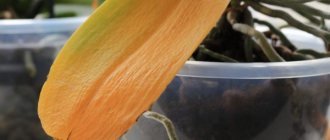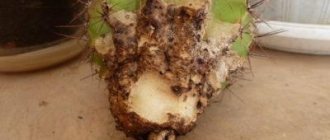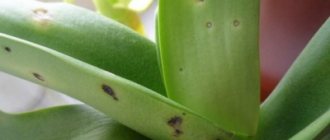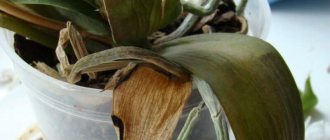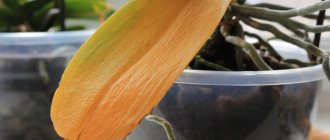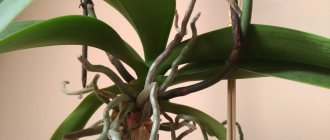Purpose of the flower arrow
After abundant and long flowering, the orchid enters a dormant state, but when the plant has accumulated enough strength, a green arrow-shaped shoot will appear. This is the peduncle, on which, with proper care, the first buds will soon appear.
After flowering has ended, you should not get rid of the green shoots. New buds or shoots may begin to form on it, making it possible to produce children.
A damaged, dried peduncle is not a final sentence . Its correct removal will allow the plant to take a break, accumulate strength and nutrients in order to give life to new green shoots and flowers.
Orchid flower stalks
A peduncle is a formed flower stem that is capable of sending out arrows and blooming . In addition, children can sometimes form on the peduncle, that is, so-called independent shoots, with the help of which the orchid can be planted.
The period of formation of the flower-bearing arrow usually takes from one to three months , after which the orchid begins its flowering period. The duration of this period can vary from 2-3 months to six months , subject to proper care, as well as high-quality watering of the plant.
Peduncle with buds.
It is also worth noting that not all orchids are capable of blooming . only adult plant specimens that have developed a good root system can produce flowers Young orchids under one year of age, as a rule, still do not have enough vitality to support the flowering process.
When is it abnormal?
The shoot may dry out for natural reasons , especially after flowering has ended.
Then this will be a normal reaction of the plant. But if the shoot has appeared recently, buds appear on it or flowering occurs, and the arrow begins to turn yellow and lose its appearance, then the matter requires intervention. Premature drying of the flowering shoot leads to disruption of natural processes, which can ultimately result in the death of the plant. With proper analysis of the situation, the condition of the orchid can be improved.
Possible problems for children
If a young plant decides to bloom, then there are two options:
- Remove the peduncle and replant;
- Wait until flowering ends.
In the first case, the baby will be stronger, and in the second, it will delight you with flowering.
No roots appear
If roots do not appear in a young Phalaenopsis within 4 months, then their appearance must be stimulated. This can be done in two ways:
- Tie a lump of damp sphagnum moss wrapped in film to the body of the orchid. You can secure it with soft wire, orchid clothespins or thread. Every day it is necessary to ventilate the baby, leaving it without moss for an hour;
- Use peat tablets or cups with substrate. In suitable conditions, the baby easily takes root.
Popular articles Daffodils planting and care in open ground
If roots do not appear for more than 6 months, then you should take care of the health of the mother plant and remove the baby.
Attention! If the baby is not planted, the orchid may die!
When separating a young orchid without roots, it is important to remember that their survival rate is low. But you can save the plant
In order for the baby to take root, it must be placed in a greenhouse and planted in sphagnum moss.
If the baby has not given roots, then it must be planted in sphagnum moss.
The greenhouse can be made from:
- Package;
- Banks;
- Or a plastic bottle.
The light is only diffused. The greenhouse is ventilated twice every day (1 hour). Watering is carried out as the substrate dries. Watch the base of the body. If it begins to turn black, then ventilation should be increased and the affected area should be sprinkled with cinnamon.
Leaves wither
If a child that has not been transplanted from an adult plant begins to wither, then it is necessary to carefully examine both of them. It is possible that Phalaenopsis began to die because of the baby or due to improper care.
Find errors in care and watch the reaction. If the leaves remain limp, then the baby should be separated and try to fight for its life separately from the mother plant.
Advice! Pay attention to the peduncle. If it begins to turn yellow, then the baby should also be planted. If the leaves of a young Phalaenopsis wither in its own pot, it means it does not receive nutrients to maintain turgor
If the leaves of a young Phalaenopsis wither in its own pot, it means it does not receive nutrients to maintain turgor.
If the leaves of a baby orchid wither, then you should reconsider its care.
It should be kept in a greenhouse and sprayed periodically. This usually happens to children without roots, and if they fail to grow them, the orchid will die.
Why can the arrow dry out completely?
The main reasons for the deterioration of the health of the flowering stem of an orchid:
- insufficient amount of light;
- excess mineral fertilizers;
- lack of nutrients;
- dry or too humid air;
- change in room temperature to an unacceptable level;
- the presence of unfavorable, stressful factors.
The following is a detailed look at what causes a flower shoot to dry out:
- Orchids are found naturally in exotic countries with tropical climates.
A prime example is Thailand, where you can find many varieties of this beautiful flower. Therefore, orchids prefer warmth, sufficient light, and moderate air humidity. In winter, daylight hours in our country are noticeably reduced, which negatively affects flowers. - Orchids do not tolerate the scorching, hot rays of the sun, but they also do not tolerate the absence of light well, so try to install the plant in a sufficiently lit place that can be protected with a special film from direct sunlight.
- Fertilizers should be used only when necessary, without deviating from the instructions in the instructions, observing the norm and dosage.
- With excessive humidity, the process of rotting is possible, but with dry air, shoots, flowers, and leaves begin to wither before our eyes.
- You can encounter hypothermia when transporting the plant during cold periods and when the room is heavily ventilated.
Monitor the temperature in rooms where there are plants. - Stressful situations are associated with a sharp change in the conditions of keeping orchids at home. This could be an incorrect or untimely transplant, a change of location or owner.
Dormant buds
A dormant bud is a bud from which a baby or flower stalk emerges. It is located on:
- Peduncle;
- Roots;
- Or the stem of a plant.
The bud is covered with dense scales. On the peduncle of Phalaenopsis, depending on its growth, there may be 2-3 waiting buds. And on the peduncle it resembles a small growth or a junction of two parts of the peduncle.
Babies always begin their growth from a dormant bud, no matter where it is:
- On the peduncle;
- On the roots;
- On the stem.
How to wake up?
To awaken a sleeping bud, you must follow all the agrotechnical rules given above, and you can also add a temperature difference between its night and day indicators. This difference should be 5 degrees. You also need to follow the main points:
- Lighting should be sufficient and last for 12 hours a day;
- The temperature should be at 26-27 degrees Celsius, and do not forget about lowering it at night;
- Humidity should be at least 75%, since reproduction takes place in the flower’s homeland during the rainy season.
IMPORTANT! While waiting for the baby to appear, it is necessary to feed the plant with fertilizers intended for orchid plants, but at the same time the proportion of nitrogen substances should be higher than the rest.
With the help of drugs
If the conditions are close to ideal, and the kidney does not awaken, it can be stimulated with a hormonal paste - Cytokinin ointment. It is based on a phytohormone, which provokes strong cell division.
To perform stimulation:
- The sheath covering the waiting bud is removed;
- The kidney is slightly damaged with a needle;
- And after that, a small amount of paste is applied to it - no more than a match head.
In a week the bud will begin to grow.
Changing the temperature regime
The temperature in the room should be at 28 degrees Celsius and not drop during this time while the baby grows and develops.
IMPORTANT! By following these rules, you can raise children on your orchid, which will also delight the gardener with their flowering.
What to do: step-by-step instructions
If the appearance of the plant does not leave much to be desired, then you should clearly analyze the conditions under which the flower is kept and take the necessary measures to stabilize the situation.
Is it worth pruning?
It is not recommended to cut a shoot that has just begun to turn yellow; wait until the sprout dries out. In this state, it will be easier to remove wilted shoots, minimally damaging the plants.
Experts and flower lovers with extensive experience recommend cutting off any shoots during the plant's hibernation period . For orchids this is the fall-winter season.
We invite you to watch a video on how to trim an orchid peduncle:
Do I need to replant?
Replant the plant at the first sign of suspected root damage, rot, or change in color of the root system.
When performing the procedure of replanting a plant, it is recommended to follow simple rules:
- carefully try to remove the plant from the pot without damaging the shoots;
- run the root system under running water at room temperature to clean them;
- if there are rotten areas or diseases, cut off the affected areas, treat them, and let them dry;
- prepare a new pot, soil mixture, drainage;
- complete the replanting process, then isolate the plant for a while, do not water it with a stream, carry out regular spraying and moistening.
Actions with dried shoots
- If the shoots turn yellow, remove only those parts that have turned yellow. When the flowering shoot dries out, it is better to remove it completely.
- After cutting off the dry parts, you should place the plant in a dormant state, limit or stop watering for a while.
How to grow and root roots
When the bud has awakened, you need to know how to grow a baby orchid from a peduncle. To do this, it is necessary to ensure that it grows roots of the required length. There is an opportunity to accelerate their growth.
To do this, the baby Phalaenopsis must be moistened with stimulating solutions: Kornevin or Heteroauxin. It is possible to also use natural remedies for this purpose: a solution of honey in water or aloe juice.
In order to enhance root growth, you can use sphagnum moss. It must be moistened in a solution of one of the stimulants and attached to the baby with a thread in the place where the roots should grow.
Note! It is necessary to water daily using a spray bottle. When the roots begin to grow, the moss is removed
If this is not done, waterlogging may occur.
After the roots grow to 4-6 cm, the baby must be separated. This can be done by cutting off a part of the peduncle several centimeters long along with the sprout.
Sometimes several shoots form on one branch. In order to cut them off, you can use sharp scissors or a scalpel, carefully separating the baby from the peduncle less than 1 cm above and below its location.
Important! It is recommended to disinfect tools before work. To do this, just dip them in boiling water.
Now you need to plant and root the sprouts. To do this, it is recommended to do the following:
- The cutting area is lubricated with coal dust for disinfection.
- For planting, you need to prepare plastic bottles with the top cut off. Their depth should be such that the roots fit freely. Several holes are made at the bottom to provide drainage.
- Plants need to be kept in water so that it covers the roots. Do this for 20 minutes. This is necessary so that they do not dry out when they are placed in plastic pots.
- Now you need to prepare the substrate in which the Cattleya or Phalaenopsis babies will grow. It is prepared in a separate container. A small piece of charcoal is placed there, crushed bark is added, then sphagnum moss is added in small pieces.
- After this, you need to plant the children in plastic containers, cutting them so that their depth matches the root system. Then the substrate is added so that it covers the roots.
When the root system develops and the orchids take root, they can be planted in permanent places.
Plant care
After the procedure for removing bad shoots, you should take care of the orchid, keeping in mind the following:
- adjust the temperature to moderate;
- exercise strict supervision over the drying out of the soil, water through a pan;
- introduce restrictions on overly dark and overly light rooms;
- humidity should not be below 50%;
- moderate ventilation is necessary, avoid drafts at all costs;
- stop using fertilizers for 3-4 weeks;
- Spray regularly.
Know that once every 2 years the orchid requires replanting, updating the soil cover, enlarging the pot if it grows well.
Remember, a dried out peduncle is only a temporary obstacle on your way to healthy and beautiful flowers on your favorite orchid. With proper removal of dried parts, their processing and care, soon new arrows will appear on the plant, ready to give life to beautiful buds .

